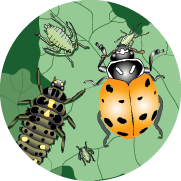What Are Safer Alternatives?
Preferred IPM methods
- Plant pest-resistant or well-adapted plant varieties such as native plants.
- Discourage pests by modifying the way you design, water, fertilize, and manage your garden.
- Alter the garden or home environment to deprive pests of the food, water, shelter, or other requirements they need to thrive.
- Keep pests out of the home and garden using barriers, screens, and caulking.
- Squash, trap, wash off, or prune out pests.
- Rely on natural enemies in your garden to kill pests, thereby eliminating the need for insecticides that may end up in our waterways.
- Pesticides should only be used when nonchemical methods are ineffective and pests are reaching intolerable levels; choose products carefully so that the least toxic, most effective material is used.

Why IPM?
Integrated pest management (IPM) uses environmentally sound, yet effective, ways to keep pests from annoying you or damaging plants. IPM programs usually combine several pest control methods for long-term prevention and management of pest problems without harming you, your family, or the environment—IPM also reduces pollution in California waterways.
Successful IPM begins with correct identification of the pest. Only then can selection of the appropriate IPM methods and materials be made.
Learn how to
Identify and manage pests with least toxic methods:
- Quick Tips provide quick answers for some common home and landscape pests.
- Home and garden page gives more detailed information for hundreds of pests.
See more tips on environmentally-friendly gardening practices:
- Biological Control (Pest Note)
- Garden Chemicals & Water Quality (Quick Tip)
- Landscape Design & Water Quality (Quick Tip)
- Landscape Plants: Fertilizing & Watering (Quick Tip)
- Lawn Watering (Quick Tip)
- Lawn Fertilizing (Quick Tip)
